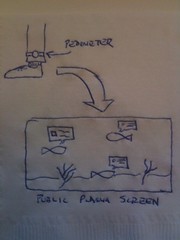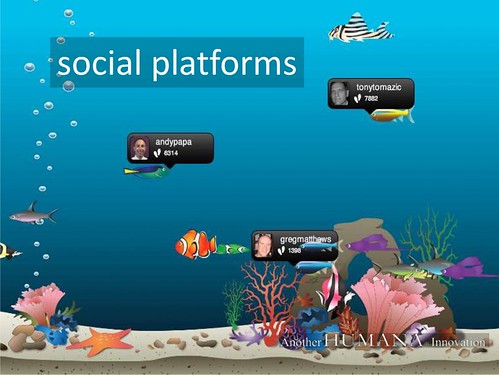Lots of folks have looked at integrating online identities, and there are various types of "single sign-on" (cite) systems around. Thought experiment for today: what would single sign-off look like? In other words, what would happen if an individual had the ability to conceptually "unplug" from the Network?
Customers Take Back The Beep
A good case study in how a customer can start a snowball rolling that effects vendor change. Back in August, David Pogue of the NYT went on a tear to get the major telecom providers to eliminate (or at least give customers a way around) the voicemail instructions that are given every time an individual calls her own, or someone else's, voicemail. It doesn't sound like a big thing, but at 15 seconds per, times millions of calls, it adds up to a whole lot of wasted customer time and money (in the form of minutes) in a hurry.
Should Customers Control Their Own Information?
Cross posted from 1to1, where Ginger Conlon and the 1to1 team were kind enough to allow me to guest post.
—
Should Customers Control Their Own Information?
by Christopher Carfi
Information about us–our actions, our
activities, our current "status," and the like–are increasingly
public, shared…usually willingly…on sites such as Facebook and
Twitter. However, a number of current trends and issues highlight that
we, as customers, may want to take a more active role in managing those
bits of social information (and much, much more). As more of our
information moves into the Network, do we really know who is looking
after it on our behalf?
On October 11, T-Mobile announced the following
to customers of their popular Sidekick mobile device: "Regrettably,
based on Microsoft/Danger's latest recovery assessment of their
systems, we must now inform you that personal information stored on
your device–such as contacts, calendar entries, to-do lists or
photos– that is no longer on your Sidekick almost certainly has been
lost as a result of a server failure at Microsoft/Danger." (Note: On
October 15, T-Mobile issued a follow-up message that some of the data
had been recovered, and the restoration would begin "as soon as
possible" for affected users.)
Similarly, on October 12, a group of more than 3,000 customers on the
photo-sharing site Flickr found that one of their favorite online
community discussion groups had been deleted by a Flickr staff member,
effectively deleting more than 5,000 community-created conversation
threads, according to this account by one of the group members.
So, what would you do if you were one of those affected customers? What if all
of your phone book contacts disappeared overnight? What if a community
that you had helped create suddenly vanished, and took with it
thousands of the words and thoughts that you had passionately created
over a period of years?
As the Network Age has evolved and more services have moved into the
"cloud," many customers have delegated authority and absolved
themselves of the responsibility of controlling their own information.
We are seeing, however, a number of initiatives that have the
possibility of bucking this trend. Groups of active customers are
beginning to take charge of their own information–information as
diverse as heathcare, fitness, and home power consumption. (An
exhaustive list of "personal informatics" resources can be found here in a great post by Doc Searls at LinuxJournal.)
So as more and more of service providers take more and more of your information, always be cognizant that it is your
information, and that you do have the opportunity to take an active
role in how it is curated (can you make local backups of the
information in your phone's contact book?), shared (do my service
providers have granular levels of privacy settings that I can set?) and
protected (is my data stored in an encrypted form, and who has the
keys?).
We as customers are becoming increasingly "virtual" as more of our
information moves into the network. It is our responsibility to take
care of our "data assets" in the same way we take care of our physical
ones.
Backstage with the Google Wave team
Had the chance to have a great conversation with the Google Wave dev team today. Here’s the audio and the full chat transcript.
Chuck Revell – SF Photog Deity
Sneaky Gnome, by Chuck Revell
Friend and Bay Area photog deity Chuck Revell has a show going up tomorrow night (15Oct) at Minibar (837 Divisadero St, San Francisco). I think the show tomorrow is 6p – 11p.
Check out more of his stuff here. Best. Eye. Ever.
Seeya there…
“I Hate Your Freedom”
Why should you, the customer, be able to control your own information?
Why does all this esoteric-seeming VRM (cite) stuff matter?
Why should you actively manage your digital identity, and your digital creation, and not delegate it to others?
Why should you care?
Humana Pedometer Game
Very cool. Humana Healthcare’s Innovation group wears pedometers, and the number of walking steps they take each day translate into which fish is “higher” in the tank.
This really hits a perfect storm of coolness. It’s connecting game-like activity to both a business AND a health goal. There’s a social aspect in that everyone can see everyone else’s fish (score), and a “friendly” bit of competition to increase their fitness. I love it. Here’s a view of the actual plasma screen.
Greg’s full presentation from #ims09 is at http://slideshare.net/chimoose – check it out.
Today: Network Age Briefing with Laura Fitton and Tantek Çelik
As part of the ongoing Supernova-sponsored Network Age Briefing series, really looking forward to chatting with Laura and Tantek today. The details:
When: Thursday, Oct 8, 3pm EDT / Noon PDT
Web and chat: http://www.blogtalkradio.com/supernova
Call-in Number: (347) 945-6578
We are moving from a web of pages and sites to a rich and continuous stream of interactions. Historically, we often thought of the web using a metaphor of “real estate,” with accompanying lexicon of “sites” and “locations.” However, as the Network Age has evolved, we now are beginning to realize that the web has duality, and also has characteristics of a real-time flow as well.
On October 8, please join us at 3pm EDT / Noon PDT for a Network Age Briefing with Laura Fitton. Laura “@Pistachio” Fitton is leading the charge of sussing out intelligent and productive business uses of emergent technologies like Twitter, where she is read by thousands of community members. The first to publish a white paper on “Enterprise Microsharing” (popularly called “Internal Twitter”), she also writes for and runs the TouchBase blog and is an early beta tester of Seesmic and Qik. She re-launched Pistachio Consulting in September 2008 to connect businesses to new ideas and innovations using all the tools of microsharing. Laura graduated magna cum laude from Cornell University’s College Scholar program.
Dedicated to advancing open standards and simpler data formats for the Web, Tantek Çelik co-founded both GMPG and the growing microformats.org open standards community after many years of experience contributing to, writing, and editing specifications at the World Wide Web Consortium (W3C).
Previously Tantek was a veteran representative to the W3C for Microsoft, where he also helped lead the development of the award-winning Internet Explorer 5 for Macintosh, the first web browser to bring widespread standards compliant HTML4 + CSS1 + PNG1 support to millions of users.Tantek has Bachelor’s and Master’s degrees in Computer Science from Stanford University, as well as a strong background in human interface and user-centered design from his many years at Apple Computer. He shares his thoughts on tantek.com and his Twitter: twitter.com/t.
Mongeese
Sidewiki
Enthralled with Google's new thing Sidewiki, which lets you comment on websites?
Start here, from Dr. Weinberger. Yes, he wrote that in 1999. No, that's not a typo.
Or do a search on the phrase "thirdvoice."

